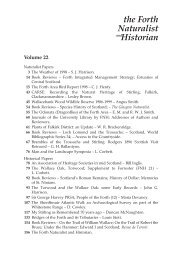fnh journal vol 24 - Forth Naturalist and Historian - University of Stirling
fnh journal vol 24 - Forth Naturalist and Historian - University of Stirling
fnh journal vol 24 - Forth Naturalist and Historian - University of Stirling
You also want an ePaper? Increase the reach of your titles
YUMPU automatically turns print PDFs into web optimized ePapers that Google loves.
<strong>24</strong> C.J. Henty<br />
later, separated by very brief spells <strong>of</strong> dry weather. The first half <strong>of</strong> March<br />
stayed unsettled, then a bright <strong>and</strong> sunny third week led to a changeable end.<br />
North-east winds in early April produced two days <strong>of</strong> snow <strong>and</strong> cold<br />
conditions, the second half was much wetter <strong>and</strong> warmer. After a warm <strong>and</strong><br />
dry start to May the second half became unsettled <strong>and</strong> much cooler, this<br />
continued until the third week <strong>of</strong> June when it became very warm <strong>and</strong> then<br />
stayed fairly dry but cloudy. Early July was warmer but still cloudy, then a<br />
cooler spell, with torrential rain on the 9th, gave way to a sunny <strong>and</strong> warm<br />
spell. Warm but changeable conditions dominated August <strong>and</strong> September with<br />
only short sunny spells, there were thunderstorms in late August <strong>and</strong> periods<br />
<strong>of</strong> heavy rain throughout September. October continued this pattern with no<br />
settled anticyclonic spells. In November primarily cloudy <strong>and</strong> wet weather was<br />
interrupted by only two short dry <strong>and</strong> frosty periods. Cyclonic systems made<br />
the first half <strong>of</strong> December windy <strong>and</strong> wet, though mild; there followed two<br />
incursions <strong>of</strong> Arctic <strong>and</strong> continental air that brought freezing temperatures <strong>and</strong><br />
then snow after Christmas.<br />
The information on the breeding numbers <strong>of</strong> common species in 2000 comes<br />
primarily from the British Trust for Ornithology’s Breeding Bird Survey. This is<br />
based on transect counts <strong>and</strong> is now sufficiently extensive to calculate numbers<br />
<strong>of</strong> birds recorded per ten kilometres for several habitat types, these are<br />
regularly mentioned in the species paragraphs. For less common species I can<br />
sometimes mention data in terms <strong>of</strong> the numbers <strong>of</strong> pairs or apparently<br />
occupied territories for particular locations. Several observers send in a list<br />
largely or entirely for their home locality, much <strong>of</strong> this information is not<br />
appropriate for these annual reports but it is valuable to have on record <strong>and</strong> I<br />
am keeping them in a special file. At the moment there are fifteen such lists<br />
referring to the whole district from Falkirk to Killin.<br />
For many species the records sent in are very unrepresentative <strong>of</strong> their<br />
general distribution, this applies particularly to very common species or to<br />
those that are secretive or breed in inaccessable places. Readers can consult the<br />
the Check List published in the <strong>Forth</strong> <strong>Naturalist</strong> <strong>and</strong> <strong>Historian</strong> Vol 15, but in<br />
addition I have in this report put, after the species name, a coded summary <strong>of</strong><br />
general distribution – which <strong>of</strong>ten apparently contradicts the detailed records<br />
that are published for the year.<br />
B - Breeding status, widespread (in more than five 10 km squares)<br />
b “ “ , local, scarce (in fewer than five 10 km squares)<br />
W - Winter status, widespread or <strong>of</strong>ten in groups <strong>of</strong> more than ten.<br />
w - “ “ , local, scarce (local <strong>and</strong> usually fewer than ten in a group)<br />
P - Passage (used when species is usually absent in winter, P or p used for<br />
widespread or local as in winter status)<br />
S or s - a few species are present in summer but do not normally breed.<br />
Thus BW would be appropriate for Robin, B for Swallow, p for Ruff <strong>and</strong> SW<br />
for Cormorant. No status letter is used if a species occurs less than every other<br />
year.



